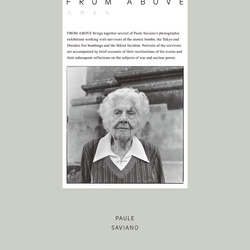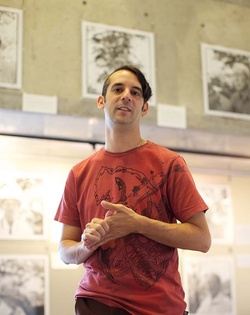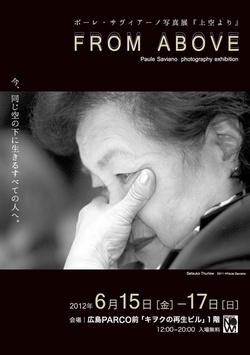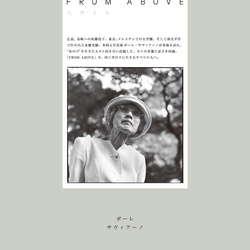The headline Portraits and memories of those who survived the war, in the Book Section of the online Japan Times,1 caught my attention immediately. The title of the reviewed book was a real teaser: “FROM ABOVE,” by Paule Saviano. The observation that the author had used a Hasselblad camera with an 80mm lens to shoot his subjects the old fashioned way, intrigued me; and although I already have quite a number of books on the Pacific War, I was anxious to see whether this was something really different; I had to get my hands on it as soon as possible. So, I went online to search about where and how fast I could get it. Fortunately I ended right at the author’s address.
—How soon can you send it?
—This Saturday.
We trusted each other, and after one of those, now more frequent, incidents with the US mail, the book finally reached me, early one Thursday afternoon. Had not my son-in-law been watering the front yard, the mailman would have just left a little yellow note indicating that a package was waiting for me at the USPO, five miles away…just to further frustrate me.
I opened the package immediately after I got it.
—Oh, me gosh! This is really classy!
Designed and executed in Japan, in the old style, the book rested inside a beautiful protective case, adorned with a couple of portraits of hibakusha.
—I hope the inside is just as classy as the outside!
I went at it immediately. It was just past 2PM. By 9PM, I realized I had not eaten dinner, but just couldn’t put the book away.
The book is divided into two parts; the first, on fine coated stock, is a poignant collection of fifty-one, superb, black-and-white portraits: beautiful people, all of them about my age, who went through what my mind is yet incapable to fathom. None of the photos show either tears or grimacing; hatred or rancor. Each subject seems imbued with an almost infinite sense of peace…yes, even those wearing a device to hide the keloids. And, the few smiles found here and there, all cast an incomprehensible sense of Sho ga nai—nothing now can be done.
On the left side of each portrait is a short comment—language minimalism that makes you squirm. I particularly loved Itaru Takehara’s2 devastating one-liner: Every portrait has a silent voice.3
The second part, executed in ivory stock is a collection of the short, but shocking stories in which the victims reveal some of their experiences. The text is perfectly distributed in Japanese and English—quite an ambitious accomplishment. After examining in detail all the photos, and reading the entries, a very simple thought comes to mind: Can there ever be any justification for the savagery of war?
Since the book had such a profound impact on me, I decided to further contact its author, Paule Saviano for ideas on how it came about.
Paule is a young, 37 year-old American photographer famous for chronicling the over-the-top and glamorous world of fashion models and rock stars,4 whom he often portrays in loud and vibrant, now colors. So, “FROM ABOVE” will certainly raise a few eyebrows in that world of make-believe, both for Paule’s choice of subject, and for his black-and-white poetic style, reminiscent of the last century’s old American masters. Even if you are just familiar with his commercial work, Paule’s dramatic new adventure will make you come up with your own: How on earth?
In 2007, Paule began writing a series of letters to organizations in Hiroshima indicating that he wanted to record, both in writing and photographically, the histories of living hibakusha.5 No progress resulted from his enquiries until the summer of 2008, when he received a reply from the Nagasaki Peace Wing—an associate of the Nagasaki Atomic Bomb Museum. So he determined to go to Nagasaki in September of 2008.
Stretching the word hibakusha to its literal Japanese meaning, Paule chose not to restrict his camera work, exclusively, to survivors of the atomic genocide. Instead, he expanded it to include survivors of the savage destruction of Tokyo and Dresden, and of the hellish experiment at Bikini. He then expanded his quest for survivors and their stories with further trips to Japan and Germany. He has made a total of twelve trips to both countries to photograph his subjects, and to exhibit the results of his work.
I started the project because I wanted to learn. I wanted to know what happened to the people underneath the mushroom cloud and the charred remains of those cities. I wanted to put a human face and a voice to events I learned about only through history books and statistics. All we see in the history books are photos of the mushroom cloud or the aerial view of a destroyed Dresden.
In school there was never any mention about the people who survived. I wanted to know how did they live their lives during and after? How did they survive? What effects did the events have on their lives?
I'm a portrait photographer. I pursue emotions in my photos. I wanted to create a permanent visual voice for these survivors. Photographs transcend languages. It is the universal language.6
Saviano’s objective was to emphasize the human side of war, particularly the effects that it has had, and still has on its survivors, seventy years after it happened. He found that the fire-bombing of Tokyo exceeded in cruelty and horror the Hiroshima and Nagasaki nuclear nightmares. The March 10, 1945 Tokyo bombing produced more immediate deaths than those that occurred at Hiroshima and Nagasaki combined. Two years after his research among the Tokyo-raid survivors, he decided to contact some of the people who survived the combined British and US air forces obliteration of Dresden, Germany.
Many believe that the day a war ends, life starts to return to normal. From being around those survivors in all the cities (even in Coventry, UK) you never recover emotionally over what you have experienced. The point is there is never a winner when it comes to war, only suffering.
Paule began his project in 2008 without the slightest idea that an exhibit or a book would emerge from his efforts. He just wanted to learn, first-hand, what the schools fail to teach about that ugly part of our history. At some time, he showed his photos to Ms. Izumi curator of the Gallery EF, in Asakusa, Tokyo; she suggested having an exhibit there, in March 2009, to open on the anniversary of the bombing of Tokyo. The event was a resounding success.
Paule continued photographing and expanding the project. By now, it has accomplished eight exhibits in Japan and Germany. Two more are now being explored to take place in 2013. The content has also been enlarged, to include portraits of survivors from Wielun, Poland; Coventry, United Kingdom; and of hibakusha who moved from Japan to other countries. Paule intends to continue the project as long as he finds survivors willing to talk. But there are several major obstacles facing him; first, finding the wherewithal to support the expenses, which heretofore have been paid by the artist himself;7 and second, racing against time, to discover those additional hibakusha who thus far have survived the ravaging of age.
The author is still searching for venues to exhibit the project in the United States, England, and other European countries. One could speculate that given the amount of universal interest on ‘Third World’ countries going nuclear, the exhibit might help increase awareness of the potential effects of a nuclear war in Asia or the Middle-East.
In July 2010, a couple of days after an interview which the Japanese news-program Zero News aired nationally, Contents Factory, of Tokyo, approached Paule. They offered him an opportunity to publish a limited edition of a book, which Paule accepted. The result was a gorgeous first of a superbly treated work. Ms. Izumi of Galley EF compiled the material for the book. Ms. Izumi, together with Eiichiro Ichikawa, and Kazuhisa Yamamoto of Donny Grafiks did the fabulous and modern design; Tomoko Nagai was the overall editor, and Dai Nippon printed the book. Because of the inclusion of the Dresden survivors, there is also an edition in German.
Without panegyrics against the imbecilities of war “FROM ABOVE” manages to be the strongest enough-of-it statement I’ve ever come across. Given the large numbers of hibakusha amongst us in Southern California, I think the author may want to take a look over here, too, before those International Living Treasures become just a memory.
Notes:
1. The Japan Times online; April 29,2012. Book Reviews; by Gianni Simone.
2. Mr. Takehara is also a photographer, similarly interested in recording some aspects of the nuclear hecatomb . He is the author of Nagasaki Urakami Cathedral, 1945-1858: An Atomic Bomb Relic Lost. (Iwanami shoten/2010)
3. Saviano, Paule; FROM ABOVE. Tokyo: Contents Factory. 2011. p/54
4. The Japan Times online. April 29, 2012.
5. Hibakusha: 被爆者, literally translates to "explosion-affected people."
6. Personal interview with the author.
7. Thus far, there have been no admission charges at any of the project exhibits.
* The book is available only through PhotoEye.com.
© 2012 Edward Moreno









